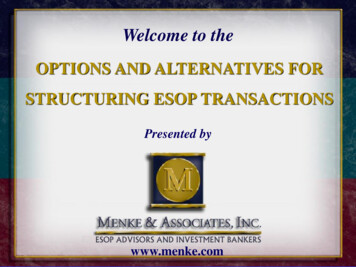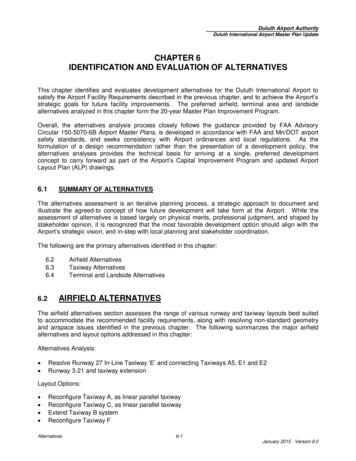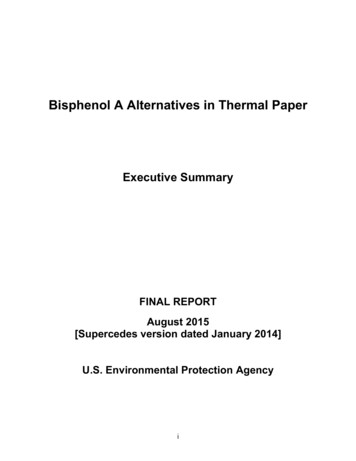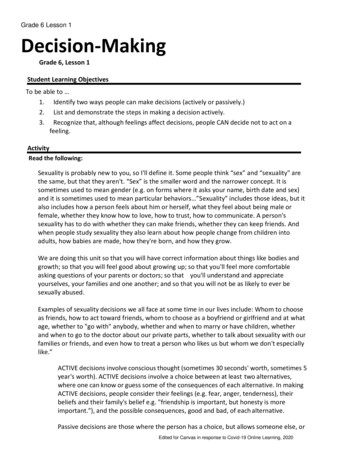
Transcription
Welcome to theOPTIONS AND ALTERNATIVES FORSTRUCTURING ESOP TRANSACTIONSPresented bywww.menke.com1
Today’s Agenda Basic ESOP Transactions Advanced ESOP Transactions Tax, financial and other considerations instructuring ESOP transactions2
Today’s Agenda Valuation Considerations–Sell now or sell later? Tax Considerations–Pay Uncle Sam now or pay Uncle Sam later?–To participate in ESOP or not to participate? Financing Considerations–To borrow or not to borrow?–To lend or not to lend? Fiduciary Considerations–To serve or not to serve as an internal fiduciary?–Appointing an independent fiduciary3
Today’s Agenda Control Considerations Whether or not to sell a controlling interest? Incentive Plans for Key Employees To motivate or not to motivate? Special Situations Q&A4
BASIC ESOPTransactions5
The Company Incorporated (TCI)Sales 10,000,000Annual Payroll 1,000,000Pre–tax Profit Net Worth (Book Value) 2,000,000Fair Market Value 3,000,000Owners:JohnPat600,00075%25%6
Case I – Gradual ESOPJohn wants to cash out on aESOP Ownership %gradual basis (e.g. start with 5% sale)10090807060504030201001234567891011Year7
Case I – Gradual ESOP 0 – 250,000TCIESOP 0 – 250,000StockJOHN8
Case II – The Prefunded ESOPShareholder(s) donot want to sell anystock this year.9
Case II – The Prefunded ESOPYear 1TCI 250,000TCI 150,000Year 2ESOPESOPResults: ESOP accumulates 400,000 ( ) for future purchaseof stock.10
Case III – Leveraged C Corp ESOP John wants to cash out more quickly At capital gains rates or tax deferred11
Bank Lends to Company, thenCompany Lends to ESOP 900,000BankESOPTCI 900,00012
ESOP Purchases StockESOP 900,00030% of TCIStockJOHN13
TCI Repays the Bank withDeductible Dollars (Principal Interest) TCI makes a deductible cash contribution to the ESOP.– Up to 250,000 plus interest. The ESOP uses that contribution to repay interest andprincipal on the company loan. TCI repays the bank loan. Bank ESOPTCI 14
More Cash To Reinvest (C corp. only)Tax–FreeESOPGross Purchase PriceLess TaxNet to SellerSeller’s Extra CashTaxableSale at 15%TaxableSale at 20% 900,000 900,000 900,000–0–( 135,000)( 180,000) 900,000 765,000 720,000 135,000 18% More Capital 180,000 25% More Capital15
Case IV – Combining ESOP Prefundingand later 30% Tax-Free Rollover SaleAssumes the Seller’s 30% Sale to the ESOP occurs in the Third Year rather than the First Year.YearCompany’sFairMarketValue30% of FMVTax–deferredsales proceedsTo cumulativeRequiredbank loanAnnualDebtService1 3,000,000 900,000 250,000 250,000 900,000 243,0002N/AN/A150,000400,000N/AN/A3 3,333,333 1,000,000N/A 400,000 600,000 162,000Results:1. Seller receives additional 100,000 in tax–deferred rollover funds.2. Seller can participate in Prefunded assets in years prior to year of tax–deferred sale.3. The required loan is reduced by 33% ( 600,000 rather than 900,000) and theCompany’s first-year principal interest debt service is reduced by 81,000 pretax.16
Case V – Combining Year-by-Year Saleand later 30% Tax-Free Rollover SaleCapital-gains sales followed by a tax-free rollover saleYear% Sale -Annual% Sale -CumulativeTaxable orTax DeferredS or C13%3%Capital-gainsS or C24%7%Capital-gainsS or C35%12 %Capital-gainsS or C418 %30 %Tax DeferredC17
Case VI – The Two–Stage ESOP BuyoutYear12345678910MarketValue SaleProceedsLoanBalance 1,500 (50%) 1,5001,200900 1,900 (50%) 2,5002,2001,9001,6001,3001,000700DebtService 450420390550530490460430400370( thousands)18
Tax–Deferred Rollover(Section 1042 Transaction) ESOP must acquire 30% or more of the stock of aprivately–held C corp. (not an S corp.) Seller must reinvest the proceeds within 12 months Funds must be reinvested in “QualifiedReplacement Property” Tax deferral continues as long as seller holds QRP19
Qualified Replacement Property “QRP” Stocks or Bonds or Notes U.S. Corporations, Public or Private Can be a Brother/Sister, but not aSubsidiary of the ESOP Company20
Unlocking the QRP Lockup 900,000From Saleof StockTo ESOP 900,000ESOPBond 720,000MarginLoanProceedsNetUnrestrictedProceedsTo Seller21
Case VII – Cash Out theMinority ShareholderPat, who owns 25%,wants to retire & cash out22
Case VIII – Pro Rata SaleJohn & Patwant to cash out pro rata23
TheSCORPORATION ESOP24
Benefits of S Corp. ESOPs ESOP’s share of S corp. earnings is exempt fromunrelated business income tax (UBIT). Taxation is delayed until distributions are made toESOP beneficiaries. Thus, a 100% ESOP-owned S corp. would NEVERpay income taxes. However, an S corp. ESOP must meet “broadlybased” test. Selling Shareholders participate in ESOP allocation25
S Corp. ESOPs Tom, age 50, owns 100% of company,“S, Inc.”, an S corp. Tom’s compensation is 210,000/year S, Inc. employs 20 other employees with totalcompensation of 840,000/year S, Inc.’s annual pretax earnings are 800,000 The fair market value of S, Inc. is 4MM26
Case IX – Leveraged S Corp. ESOP(Seller Financed)STEP 1S, INC.NOTE FOR 4 MMESOPTOMSTOCK 100%27
Leveraged S Corp. ESOP(Seller Financed)S, INC.TOMTOM CONTRIBUTIONSSTEP 2&DISTRIBUTIONSNOTE PAYMENTSESOP*ESOP* Stock is allocated to participants as a note payments are made28
Leveraged S Corp. ESOP(Seller Financed)Seller Note Option Conventional Seller Note– 10 to 15 year term with prepayment provisions– 6% to 8% interest rate Fully Priced Seller Note– 10 to 15 year term with prepayment provisions– IRR of 13%, based on comparable mezzanine loan rates– 6% to 8% current-pay interest– Warrants for 10% - 20% ownership to make up thedifference29
Leveraged S Corp. ESOPEND RESULTS:1. S, Inc. shareholders pay no more income tax!2. Tom receives 4MM and, on the gain, paysonly capital gains tax (not ordinary income tax)3. Tom is allocated 20% of ESOP stock (which he will be able tocash out when he leaves Company)4. Since Company avoids making distributions to fund S corp.shareholders’ income tax (now nonexistent), additionalCompany funds are available to repay debt and increaseCompany value30
Advanced ESOP Transactions31
Session #13 Advance ESOP TransactionOverwiew Section 1042 Transaction and Floating Rate Notes Combination Redemption / ESOP buyout Stock warrants & Deferred Interest Convertible Preferred Stock Series Sales / Multi-stage Transactions Refinancing ESOP Loans ESOPs and Safe Harbor 401(k) plans32
Section 1042 Transaction and Floating RateNotes (“FRNs”)1Company ESOP2 310% Seller90% QRP FRN433
Seller Financing and Floating Rate NotesESOPSellerNote1Stock210% SellerFRN90% 34
100% Buyout: Combo Redemption / ESOPPurchaseCash CompanyESOP5%95%NoteCashSeller More flexibility with purchase price More flexibility on seller note terms of collateral Helps manage company’s repurchase obligation Seller note has higher interest rate (mezzanine debt) Disadvantage: 1042 probably not available Disadvantage: state solvency laws35
Redemption Coupled with 6
Stock Warrants and DeferredInterestCompanyPromissary Note w/warrants or deferredinterestStockSeller37
Stock Warrants Gives the holder a right to purchase companystock at a specified price at a future date Almost identical to an option Used in Seller-financed transactions Issued in lieu of a higher interest rate on theseller note38
Stock Warrants Example: 15% total IRR with 8% cash pay 7% of notebalance (per year compounded) would represent apredetermined number of warrants (a certain ownership %) inthe Company to enable sellers to acquire shares in the futureat a pre-determined price Sellers often have right to put warrants to Company for cashonce all transaction debt has been repaid Company may request a “call” feature39
Payment in Kind (PIK) Interest Also known as “Deferred Interest” or“Accrued Interest” Interest is accrued and paid at a later date Less risky than warrants40
Payment in Kind (PIK) Interest Typically in connection with junior financing (sub debt, sellerfinancing or equity) Can be used when the Company lacks cash flow to pay therequired junior debt cash interest Accrues to the note balance–Example: 15% total IRR with 8% cash pay 7% PIK interest wouldaccrue to note balance Accrued interest compounds each year with the annualinterest calculation made using a higher note balance All unpaid interest (PIK) is paid at note maturity41
PIK vs. Warrants as Components ofJunior Note ReturnJunior Note Return FeaturePIK InterestWarrantsAdvantagesDisadvantages May create phantom Simple Structureincome Less costly to implement Ordinary income tax rates Capital gains tax rates More complicated Possibly higher return if More costly to implementnote giving rise to warrantis prepaid May result in higherreturn if forecastexceeded42
Case Study: 100% Leveraged 1042ESOP TransactionStep 1 – Outside Financing: (1) 12MMbank term loan, (2) 13MM bridge loanfrom bank, (3) 10MM Mezzanine DebtABC CorpStep 5 – Repay Bridge Loan ( 13MM)Step 2 – 35MMLoan to ESOP(“Inside Loan”)ESOPLenders(Bank & Mezz Firm)Net Cash before 1042 Deferral: 22MM and Approx. 18.5MMafter 1042 deferralStep 3 – ESOP pays 35MM)cash for 100% of ABC Stock1042 DeferralShareholdersStep 6 – Invest in QualifiedReplacement Securities(approx. 3.5MM)43
Case Study: 100% ESOPTransactionSELLERS Receive a total of 35MM for the sale of ABC Corp stock:– 22MM cash (from 12MM senior debt loans and 10MMmezzanine financing)– 13MM subordinated seller notes Sellers may elect to defer (possibly permanently) capital gainstaxes on entire sale by investing in qualified replacementsecurities (e.g. Floating Rate Notes or “FRNs”) If 1042 Deferral is elected, Capital gains tax savings up to 7MM (assumes 35.0MM price, stock basis of 0 and 20%federal long-term capital gains tax rates)44
Convertible Preferred Stock(C Corps only)Step 1: Recapitalization of the Company, convertiblepreferred stock issued to sellerDividendStreamEquityportionStep 2: Seller sells convertible preferred stock to ESOP at a higherpriceESOPConvertiblepfd sharesSeller45
Convertible Preferred Stock (continued)Step 3: Company pays cash dividend to ESOPindefinitely, unless ESOP fiduciary converts tocommon stockCash DividendCompany ESOP46
Convertible Preferred StockAdvantages & Disadvantaages Advantage: Higher purchase price for seller Advantage: Seller retains control of the company Advantage: Section 1042 available Disadvantage: Less flexible, creates an obligation for thecompany Disadvantaage: Dividend could be potential cash drain to thecompany Disadvantage: Company must be recapitalized Disadvantage: Not available for S Corps47
Seriel Sales / Multi Stage TransactionsESOPA 30% sale at a control price,ESOP has option to buyadditional 70% at a control priceSeller Advantage: Higher purchase price for seller Advantage: Section 1042 Rollover available Disadvantage: Passage of control must occur sooner Disadvantage: Independent fiduciary should be used Disadvantage: Seller loses flexibility on timing of future sales48
Refinancing Seller-Financed LoansStep 1: Original seller – Financed Transaction:ESOPNoteStockSeller49
Refinancing Seller-Financed Loans(cont.)Step 2: RefinancingESOP noteSellerCompanyCash and/orcompany note50
Refinancing Seller-Financed Loans(cont)Step 3: PaymentsNote PaymentsCompanyESOPContributionsNote PaymentsSeller51
ESOPs and Safe Harbor 401(k) PlansEmployer Safe Harbormatching contributionsESOPCompanyEmployee salarydeferrals401(k)Plan52
401(k) Safe harbor Requirements Alternatives1. Matching contribution to NHCEs Up to 3% of compensation Plus up to 50% of the next 2% of compensation, or2. Discretionary contribution up to 3% ofcompensation to NHCEs (whether or not theydefer salary) All safe harbor contributions are 100% vested53
Valuation Considerations Sell now or sell later?– Sell now Assumptions:– Pre-tax earnings of 1.67 million– Valuation multiple of 6x 10 million– Basis of zero– 2012 Tax rate of 20% (federal plus state)– 100% sale to ESOP– Net proceeds: 8 million54
Valuation Considerations Sell later – higher tax rate Assumptions: Same pre-tax earnings of 1.67 millionSame valuation multiple of 6X 10 millionPotential tax rate of 28.8% (federal plus state)Net proceed: 7.1 million55
Valuation Considerations Sell later – higher tax rate and lower value Assumptions: Pre-tax earnings of 1.4 millionValuation multiple of 5X 7 millionPotential tax rate of 28.8% (federal plus state)Net proceeds: 5 million56
Valuation ConsiderationsSecond Stage Transaction Sell now Potentially lower tax rateBut lower value if prior debt is still outstandingImpact of new debt on value of participants’ existing sharesCash flow impact of new debtImpact on contribution limitsIs a repurchase liability study needed Sell later Potentially higher tax rateHigher value if prior debt is fully repaidLess cash flow impactLess impact on contribution limitsIs a repurchase liability study needed57
Tax Considerations C corporation strategies C corp remains as C corp Taxable sale now– Pay current federal capital gains tax– Seller participates in ESOP58
Tax Considerations C corporation strategies C corp remains as C corp Tax-free rollover sale––––No current tax on sale of stockIf QRP sold later, capital gains tax may be higherIf QRP never sold, estate gets a step-up in basisSeller (and seller’s family) and 25% shareholders (andtheir families) are excluded from ESOP59
Tax Considerations C corporation strategies C corp switches to S statusAdvantages ESOP tax shield– Bank and/or seller note can be paid back faster S corp distributions can be used to pay bank debtand/or seller note– Avoids contribution limits– Avoids allocation limits– Avoids limits on deductible dividends60
Tax Considerations C corp switches to S statusDisadvantages Must adopt calendar yearShort period accounting statementsShort period tax returnsBuilt-in-gains taxOne class of stockSwitch from LIFO to FIFOLIFO recaptureTaxation of fringe benefits to 2% shareholdersLoss of NOL carryoversAnti-abuse provisions- §409(p)61
Tax ConsiderationsSecond Stage Transactions If ESOP acquires less than 100% Advantage of remaining a C corp Continued availability of §1042Advantage of switching to S status ESOP tax shieldS corp distributions can be used to pay bank debt and/or sellernote If ESOP acquires 100% No advantage in remaining a C corp62
Tax Considerations S corp strategies S corp remains as an S corp Advantages– Tax rate is low if basis is high– Sellers and their family members participate inallocations– S corp distributions can be used to repay ESOP loan– ESOP tax shield on S corp distributions enables fasterpay down of ESOP loan Disadvantages–1042 election not available63
Tax Considerations S corp strategies S corp switches to C corp before year end Advantages– Sellers can elect 1042 Disadvantages––––––Short period accounting statementsShort period tax returnsSellers and family members cannot participate in ESOPCorporation will be subject to income taxation5 year wait to switch back to S corpESOP will not have access to S corp distributions to helprepay loan amount– Corporation must use accrual method of accounting– Corporation may be liable for income tax on accountsreceivables64
Financing Considerations To borrow or not to borrow? Borrow if: Want to lock in capital gains rateWant to lock in current valueSeller plans to elect 1042 and need to purchase QRPDo not borrow if: Company is in a cyclical industryBorrowing will use up company’s line of creditBorrowing will otherwise jeopardize company’sfinancial securityPersonal guarantees are a concern65
Financing Considerations To lend or not to lend? Advantages of using seller notes: Seller can lock in current valuationSeller can be more flexible than a bankSeller can still lock in capital gains rate, providedthat seller elects out of installment sale treatment66
Financing Considerations To lend or not to lend? Advantages of using seller notes: Seller can still qualify for 1042 treatment bybuying Floating Rate Notes (“FRNs”)––––FRNs are issued by Fortune 500 companiesInterest rate floats with T-bill rateMarket value does not fluctuateThus, FRNs can be purchased on margin with as little as10% or 15% down67
Financing Considerations To lend or not to lend? Advantages: Seller can earn interest at the same rate that a bankwould chargeSeller may charge a mezzanine rate of interest incertain casesSeller may receive warrants in certain cases– May or may not be worth more than deferred interest– But warrants may qualify for capital gains treatment68
Financing ConsiderationsSecond Stage Transactions If there is a prior bank loan, seller note will besubordinate to bank loan C corp dividends and S corp distributions on bothallocated shares and unallocated shares can be usedto repay an ESOP loan But dividends and distributions paid on a prior blockof stock cannot be used to make loan payments on aloan used to acquire a second block of stock69
Fiduciary Considerations To serve or not to serve as an internal fiduciary Wearing two (2) hats Seller is not prohibited from serving as trustee/fiduciaryInsider’s knowledge of the company may be beneficialTransaction costs & efficiencies70
Fiduciary Considerations To serve or not to serve as an internal fiduciary ERISA provisions: But seller has a conflict of interestAnd fiduciaries have personal liability for:– Prohibited transactions– Breaches of fiduciary responsibility Fiduciary must obtain independent appraisalBut fiduciary is still responsible for determining– Reasonableness of assumptions– Correctness of valuation methodology– Correctness of conclusion71
Fiduciary Considerations To serve or not to serve as an internal fiduciary ERISA provisions:– 406(a) of ERISA sets forth a list of prohibited transactions– Any purchase of stock by a qualified plan from a party ininterest is a prohibited transaction– But 408(e) of ERISA creates an exception for ESOPs ifcertain conditions are met– Case law provides for a presumption of good faith in thecase of an independent fiduciary– If the fiduciary is conflicted, however, there is nopresumption of good faith and the seller has the burden ofproof72
Fiduciary Considerations To serve or not to serve as an internal fiduciary Consequences of fiduciary breach: Fiduciary is personally liable to participants for alldamagesSeller must repay the overpayment, plus 15%penalty tax per annum until correctedSeller may incur thousands of dollars in legalexpensesRemoval as plan fiduciaryFiduciary liability insurance73
Fiduciary Considerations Appointing an independent fiduciary Possible solutions: retain an independent fiduciary(“I.F.”) to represent the ESOPSteps in the process I.F. is retained on behalf of the ESOP–– Engagement is usually only for purposes of the currenttransactionBut I.F. can also be engaged to serve on an ongoing basis as atrusteeI.F. assumes liability for the investment and control of trustassets relating to the transactionI.F. hires the independent appraiser and reviews the appraisalanalysis prepared by the independent appraiserI.F. retains independent counsel to conduct necessary legaldue diligence and to review all transaction documents74
Fiduciary Considerations Appointing an independent fiduciary Steps in the process I.F. obtains a Fairness Opinion from theindependent appraiser regarding the terms of thetransaction–––––Term of seller noteInterest rate on seller noteFairness of any covenant not to competeFairness of employment agreementsFairness of other consideration paid to seller75
Fiduciary Considerations Appointing an independent fiduciary Advantages of retaining I.F. Avoids liability for serving as a conflicted internalfiduciaryPromotes transparency to the employeesThis is a relatively cheap form of insuranceDisadvantages of retaining I.F Additional time to close (60-75 days)Additional costs––––Independent fiduciaryIndependent counselFairness OpinionTotal 25,000 - 35,000 15,000 - 25,000 10,000 - 20,000 50,000 80,00076
Fiduciary ConsiderationsSecond Stage Transactions Risk of overleveraging If company is overleveraged, can seller note berefinanced or extendedDOL position – Field Assistance Bulletin 2002-1 Risk of reducing the value of existingparticipants’ company stock accounts Possible solutions Valuation protocolDeferred distributions77
Control Considerations Whether or not to sell a controlling interest? What is control? Control of Board of DirectorsControl of Plan CommitteeWhen is it necessary for seller to keep control? When selling a minority interestWhen selling a majority interest in exchange for aseller noteWhen selling a majority interest for cash, butlending bank still requires seller’s guarantee78
Control Considerations Advantage of retaining control Assures that seller note and/or bank loan will berepaidAssures that company will continue to beproperly managedProvide time to properly train successormanagement Disadvantage Seller will not get control premium priceSeller must continue managing the business79
Control Considerations Advantage of giving up control Seller will get control premium priceSeller can retire from active managementAccomplish the transition to new management Disadvantages Seller will no longer be able to controloperations and or feel involvedSeller note, if any, may be less secure80
Control Considerations Alternatives to giving up control Give up control, but retain input and influenceby staying on the Board of Directors and on thePlan CommitteeGive up control but retain loan covenants thatprohibit certain corporate actionsGive up control, but retain right to regaincontrol in the event of a payment default on theseller’s noteRetain control of the Board of Directors butappoint an ongoing trustee to represent theESOP81
Corporate Governance If seller keeps control Seller must mindful of fiduciary obligation tomanage the ESOP in the best interests of theparticipants If seller transfers control to others aftercompleting a second or third stage transaction Seller may be liable for fiduciary breach if hissuccessor is not property qualified82
Incentive Plans for Key Employees To motivate or not to motivate? Why an incentive plan for key employees is needed Key employees receive a relatively small percentage ofthe ESOP sharesBanks and some large suppliers may require that keyemployees have skin in the gameAvailable tools Deferred CompensationPhantom Stock PlansStock Appreciation Rights (SARs)Stock OptionsStock Purchase PlansManagement Stock Bonus Plans83
Incentive Plans for Key Employees To motivate or not to motivate? Deferred Compensation Advantage– Disadvantage– No equity potentialPhantom Stock Plan Advantage– Has equity potentialDisadvantage– Simple and easy to administerNot actual stockStock Appreciation Rights Advantage– Has equity potentialDisadvantage––Has value only if stock appreciatesNot actual stock84
Incentive Plans for Key Employees To motivate or not to motivate? Stock Option Plan Advantages– Has equity potential– Is actual stock Disadvantages– Has value only if stock appreciates– Employee has to pay the exercise price Stock Purchase Plan Structure– Employee buys newly-issued stock from the company,or– Employee buys outstanding stock from existingshareholders85
Incentive Plans for Key Employees To motivate or not to motivate? Stock Purchase Plans Is actual stockCompany and/or selling shareholders receive cash for sharessoldDirect purchase from a selling shareholder is especiallyfeasible in the case of S corps. Key employees can purchaseshares from existing shareholders in exchange for promissorynotes that can be paid off with future funds that suchemployees receive as their share S corp distributionsDisadvantage In the case of C corps, key employees are seldom able tofinance the direct purchase of company stock86
Incentive Plans for Key Employees To motivate or not to motivate? Management Stock Bonus Plans (MSBPs) Structure–Company grants newly-issued shares to key employeesan a year-by-year basis based upon the attainment ofperformance goals, such as exceeding a base level ofprojected profits– These shares are forfeitable and non-transferable untilthe employee retires, dies or becomes disabled– The employees is not taxable on these shares until theforfeiture restrictions are removed Advantages– Is actual stock– Employee does not have to pay money out of pocket Disadvantages–Can be dilutive unless strictly based upon performance87
Incentive Plans for Key Employees To motivate or not to motivate? Legal and financial issues Incentive plans are treated as a current expense forfinancial statement purposes. Thus, the companymust be careful not to overly dilute its pre-taxearnings by issuing too much incentivecompensation in any given year Management Stock Bonus Plans and Stock OptionPlans result in the issuance of new shares ofcompany stock. Thus, the company must be carefulto not overly dilute its shareholder equity byissuing too many shares of company stock in agiven year88
Special SituationsSecond Stage Transactions Simultaneous ESOP purchase and stock redemption Where prior ESOP loan is outstanding this structure helpsto avoid exceeding the IRS limits on deductiblecontributions and annual additions Because fewer shares are outstanding after theredemption, the negative valuation impact of the new debtis offset by an increase in the total value per share ofoutstanding shares89
Special Situations Asset purchase by ESOP-owned company Objective Due to pending liabilities, Company wants topurchase assets rather than stock, orSeller wants to sell assets in exchange for cash, aseller note, and an earn-out provisionApplications Can be used either by a C corp or an S corpCannot be used in a 1042 transaction90
Special Situations Asset purchase by ESOP-owned company Steps in the transaction Management forms a Newco with paid-in capitalof 10,000Newco establishes an ESOPESOP purchases all of the outstanding stock ofNewco in exchange for a promissory note in theamount of 10,000 payable over a term of 10 or15 years.91
Special Situations Asset purchase by ESOP-owned firm Steps in the transaction Newco borrows say, 10 million from a bank,secured by the assets to be purchasedNewco purchases the assets from company X inexchange for 10 million of cash, a promissorynote of, say, 5 million, and an earn-out of up to 5 million if earnings over the next 5 yearsexceeds projections92
Special Situations Asset purchase by ESOP-owned firm Legal issues The sale of Newco stock to the ESOP will notqualify for capital gains treatment, but there isno gainThe fiduciary issues under this type oftransaction require the use of an independentfiduciary and the procurement of a fairnessopinion from the independent appraiser93
Menke & AssociatesTotal ESOP IGN ES94
Options and Alternatives for Structuring ESOPTransactionsQuestionsandAnswers95
THE ENDThank You For Attendingwww.menke.com96
ESOP Transaction ABC Corp Lenders (Bank & Mezz Firm) ESOP Shareholders 1042 Deferral Step 1 - Outside Financing: (1) 12MM bank term loan, (2) 13MM bridge loan from bank, (3) 10MM Mezzanine Debt Step 5 - Repay Bridge Loan ( 13MM) Step 3 - ESOP pays 35MM) cash for 100% of ABC Stock Step 2 - 35MM Loan to ESOP ("Inside Loan")











